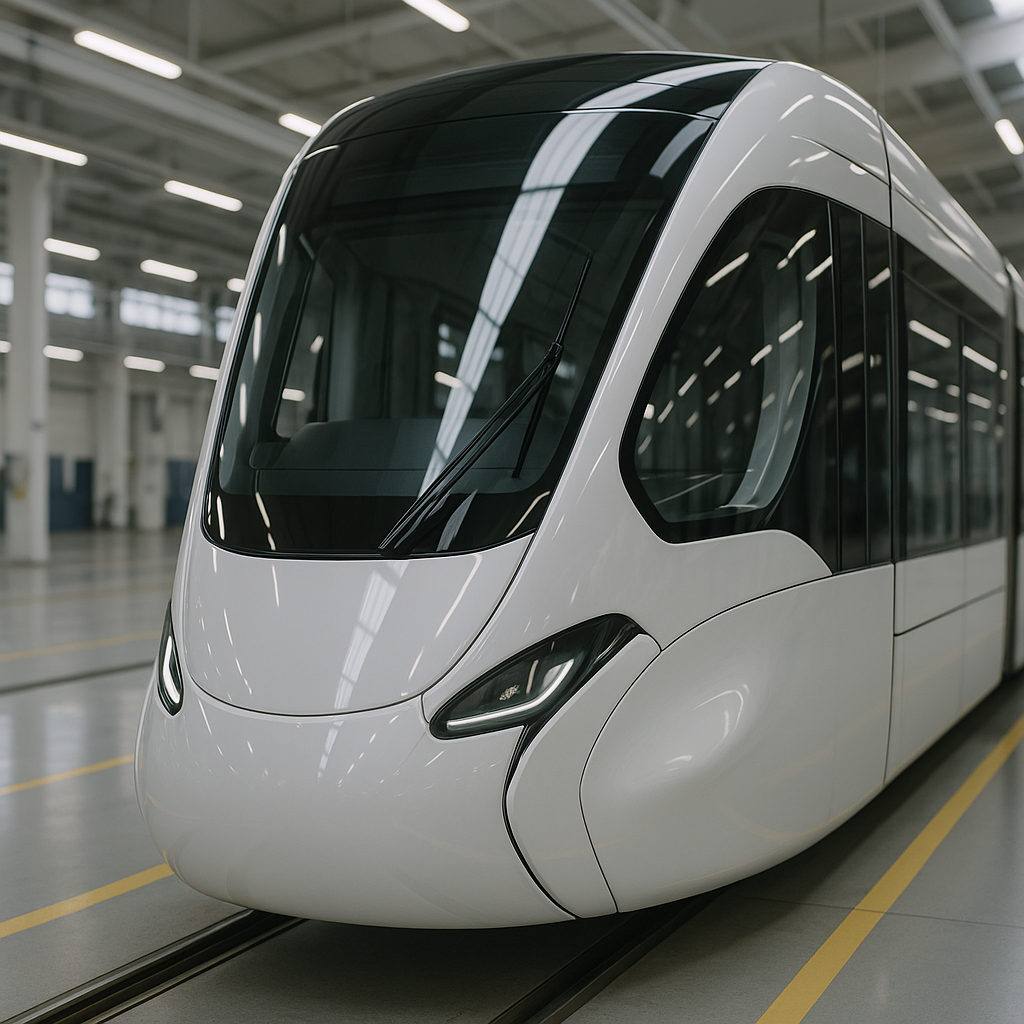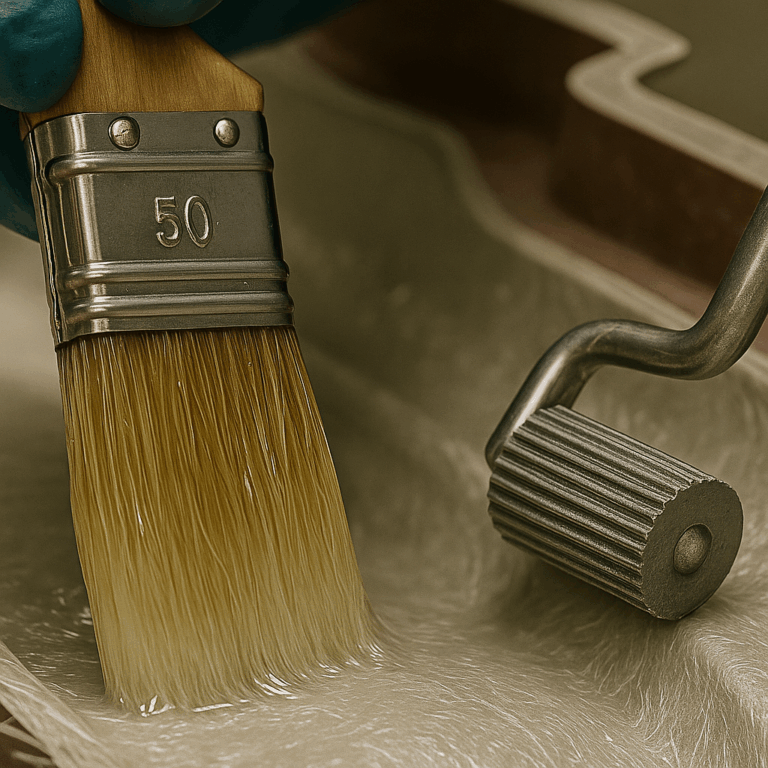Düsseldorf
Bonner Str. 367-371
40589 Düsseldorf
Phone:+49 211 515 81 70
Fax:+49 211 515 81 728
Email: info@trade-world-one.de
Vienna
Rathausstrasse 21/12
1010 Vienna
Phone: +43 664 171 89 69
Email: kontakt@trade-world-one.at
Glass fiber (GRP): The strategic material solution for transport and environmental technology
Introduction: The invisible revolution with fiberglass GRP
In a world in which the demands on our transport and environmental infrastructure are constantly increasing - higher cycle times in public transport, stricter environmental regulations, longer maintenance intervals and the demand for maximum resilience - materials such as glass fiber (GRP) are coming into focus, which perform better than traditional materials such as steel or aluminum. As your technical procurement partner with deep-rooted industry DNA, we at Trade World One are not only observing this change, we are actively helping to shape it. One material that has established itself as a cornerstone for future-proof solutions is glass fiber reinforced plastic, better known as GRP.
For many engineers and technicians, GRP is a familiar term. However, its true strategic importance only becomes apparent when we take a closer look at its properties, processing options and, above all, its practical application. Glass fiber (GRP) is not a catalog product; it is the basis for tailor-made, high-performance solutions that are precisely tailored to the challenges of our customers - transport companies, public utilities and industrial plant operators. In this technical article, we take a deep dive into the world of fiber-reinforced composites and show why glass fiber (GRP) is indispensable in modern transport and environmental technology and how we, as your implementation partner, can leverage its potential for your projects. We speak your language: technical, precise, solution-oriented.
Do you have any questions? Feel free to contact us at any time.
» To the contact page
The anatomy of GRP: a symbiosis of fiber and matrix
To fully understand the potential of glass fiber (GFRP), we need to look at its composition in detail. A GRP composite is not a monolithic material, but a composite whose outstanding properties result from the intelligent interaction of two fundamentally different components: the reinforcing fiber and the surrounding matrix.
The reinforcing fiber: the backbone of GRP strength
The eponymous component, the glass fiber, is responsible for the mechanical properties - tensile strength, stiffness and impact strength. Depending on the requirement profile, different fiber types are used, the selection of which is decisive for the performance of the GRP end product:
- E-glass (electrical glass): By far the most commonly used type. E-glass is cost-effective, has excellent electrical insulating properties (hence the name) and offers good mechanical strength. It is the all-rounder for most applications of fiberglass (GRP) in transportation and environmental technology, from vehicle cladding to control cabinets.
- S-Glass (Strength Glass): This type offers significantly higher tensile strength and a higher modulus of elasticity than E-glass. S-glass is used in highly stressed, safety-critical GRP components where maximum mechanical performance with minimum weight is required.
- C-Glass (Chemical Glass): C-glass is characterized by its particularly high resistance to chemical attack, especially from acids. This makes it the ideal material for GRP solutions in environmental technology, for example for lining chemical tanks or pipelines for aggressive media.
- AR glass (alkali-resistant glass): Specially developed for use in cementitious matrices, AR glass resists the highly alkaline environment of concrete and thus prevents degradation of the fibers.
The fiber architecture is the key to the tailor-made performance of glass fiber (GFRP): We can align the orientation of the fibers precisely with the load paths of the component - a design freedom that metallic materials do not offer.
The matrix: The protective and shaping partner in the GRP network
The matrix, usually a thermosetting resin, embeds the fibers, protects them from external influences (moisture, chemicals, UV radiation), transfers the forces and gives the GRP component its final shape. The choice of resin system is at least as critical as the choice of fiber:
- Unsaturated polyester resins (UP): The standard resin system for many general GRP applications.
- Vinyl ester resins (VE): Offer significantly higher chemical resistance and mechanical performance. They are the standard in chemical process technology for GRP pipes and tanks.
- Epoxy resins (EP): The high-performance system for glass fiber (GRP). Epoxy resins offer the best mechanical properties and result in components with maximum strength, rigidity and fatigue strength, ideal for highly stressed structural components.
Fiber-matrix adhesion is the critical factor that determines the quality of the GRP composite. This underlines the need for precise process control, which we ensure at Trade World One.
Manufacturing processes for GRP: from raw material to customized solution
The enormous design freedom of glass fibre (GRP) is only made possible by a large number of specialized manufacturing processes. Choosing the right process is crucial for quality and cost-effectiveness. As your technical procurement partner, we select the optimum method for your application.
- Hand laminating/fiber spraying: Ideal for prototypes and small series.
- Resin infusion processes (RTM, VAP, etc.): The process of choice for series components made of fiberglass (GRP) in transport technology, such as front masks for trains, as it delivers components with smooth surfaces on both sides and excellent quality.
- Pultrusion (extrusion): A continuous process for the production of pultruded GRP profiles (e.g. U-profiles, pipes, gratings). These are extremely strong and are increasingly replacing steel in corrosive environments, for example as GRP cable ducts in railway tracks or load-bearing structures in sewage treatment plants.
- Winding process (filament winding): Ideal for rotationally symmetrical GRP components such as high-pressure pipes, tanks and drive shafts, where the properties can be precisely adapted to the load.
- Pressing process (SMC/BMC): Suitable for large series with high dimensional accuracy requirements, for example for body parts or housings made of fiberglass (GRP).
Knowledge of these manufacturing processes for glass fiber (GRP) is part of our industry DNA. We think not only in terms of material, but also directly in terms of the right manufacturing process for your solution.
The unbeatable advantages of fiberglass (GRP) in practical use
The property profile makes fiberglass GRP predestined for transport and environmental technology.
Absolute corrosion resistance: a core advantage of fiberglass (GRP)
This is perhaps the most outstanding advantage. Unlike metals, fiberglass (GRP) is immune to electrochemical corrosion. This means: no rust. Components such as pipes, shafts, pool covers and gratings made of GRP have a service life that exceeds that of steel many times over - with minimal maintenance.
High lightweight construction potential: specific strength and rigidity
Glass fiber (GRP) has a density of only approx. 1.8 - 2.1 g/cm³ (steel: 7.85 g/cm³). At the same time, high-strength GRP laminates can exceed the strength of structural steel. The result is excellent specific strength, which directly saves drive energy in vehicle construction, reduces wear and enables higher payloads.
Excellent electrical insulation: safety through glass fiber (GRP)
In railroad technology, electrical insulation is a safety-critical property. GRP is an excellent insulator. This property is used for insulated sleepers, conductor rail covers and housings for signaling technology, which reliably protect against stray currents with glass fiber (GRP).
Maximum design freedom and functional integration
The shaping of GRP enables highly complex geometries that would be almost impossible to achieve with metals. The material also allows a high level of functional integration: stiffening ribs, inserts and cable guides can be laminated directly into the component, which reduces assembly work and weak points.
Superior life cycle costs (LCC)
While the initial costs for a GRP component can be higher, GRP is often the far more economical solution over the life cycle. The elimination of corrosion protection and the reduced maintenance requirements lead to significantly lower total cost of ownership.
Procurement and engineering of fiberglass (GRP): Where Trade World One makes the difference
Realizing the advantages of GRP poses challenges for purchasers and engineers. This is exactly where our work as a technical problem solver begins.
The crux of the specification: precision for every GRP component
A GRP component is not a standard part. Its properties are defined by dozens of parameters. An incomplete specification can lead to component failure. Our solution: We translate your requirements - whether mechanical load, chemical exposure or fire protection in accordance with EN 45545 - into a watertight technical specification for the production of glass fiber (GRP) by our certified manufacturing partners.
Obsolescence management and reverse engineering with GRP
What do you do if a critical metal component fails and no drawings exist? Our solution: We practice technical reverse engineering. We analyse the old part, record its geometry and design a new, optimized component made of GRP. This is not just a 1:1 replacement, but a technical improvement: lighter, corrosion-free and low-maintenance. Our ability to replace obsolete parts with superior GRP solutions ensures the operational readiness of your systems.
Quality assurance for high-quality GRP components
The procurement of high-quality GRP components requires a global network and the highest quality standards. Our solution: We do not supply untested goods. Every GRP component undergoes our strict ISO 9001-certified quality process. From the auditing of suppliers to the final inspection in our 1,500 m² warehouse, we ensure quality along the entire chain. While others are still discussing, we deliver the tested, documented fiberglass solution.
Outlook: The future of glass fiber (GFRP) and smart composites
The development of GRP is not standing still. We see three main trends:
- Smart Composites: Integrated sensors enable real-time monitoring of GRP structures (structural health monitoring) for predictive maintenance.
- Sustainability and recycling: New processes for recycling GRP components and the use of bio-based resins are becoming increasingly important.
- Automation and digitalization: Robot technology and simulation will enable the production of even more complex and optimized glass fibre structures.
Conclusion: Your implementation partner for GRP solutions
Glass fiber reinforced plastic (GRP) is far more than just a “plastic”. It is a highly engineerable material that provides the tools to meet the key challenges in transportation and environmental technology: corrosion, weight, efficiency and durability.
However, the successful implementation of GRP solutions requires more than just knowledge of materials. It requires in-depth technical understanding, process-safe procurement expertise and absolute reliability. This is precisely Trade World One's DNA. We are not just a supplier, we are your technical problem solver. Whether it's the development of a new lightweight, fireproof battery box made of GRP, the replacement of a rusted steel beam or ensuring the supply of spare parts - we will find a solution with the optimum fiber composite material.
Fast, reliable and exactly to specification. Because while others are still discussing, we are already delivering. Components. Solutions. Availability. That is our promise.
Sources
- Fatigue behavior of glass fiber-plastic composites (scientific dissertation)
- Sustainability assessment of glass fiber reinforced plastic (GRP)
- Influence of hybrid 3D fabrics on the fatigue behavior of GFRP (scientific publication)
- Occupational safety and health protection for fiber-reinforced plastics (BGETEM)
- Research into the recycling and recovery of glass fiber and carbon fiber composites
- Documentation on the dismantling and recycling of wind turbines with GRP components
- Scientific paper on GRP as a building material (University of Rosenheim; additional source)
- Study on the thermomechanical behavior of GRP (Federal Institute for Materials Research and Testing)
- Hazards due to fibrous dusts when handling GRP (DGUV)
- Specialist articles on GRP as a lightweight construction material in industry and technology
Do you have any questions? Feel free to contact us at any time.
» To the contact page

